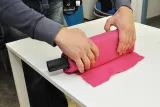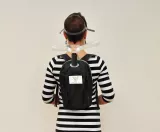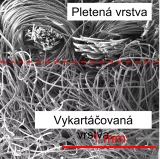Published: 13.07.2022
Scientists from the Centre of Materials and Nanotechnologies, Faculty of Chemical Technology, University of Pardubice in cooperation with the Institute of Chemical Process Fundamentals, CAS and Textile Testing Institute in Brno developed a personal filter against SARS-CoV-19 which could be well used in developing countries. The entire assembly, which fits into a backpack, does not use nanomaterials but commonly available fleece-like polyester fabric. The original system designed by Czech scientists has been published in the prestigious American scientific magazine PLOS one.
“Our material has an outstanding ratio between the amount of virus (aerosol) it captures and breathing resistance. It is therefore comparable to materials used in FFP3 respirators,” says the principal author of the study Ing. Max Fraenkl, Ph.D. from the Centre of Materials and Nanotechnologies, Faculty of Chemical Technology, University of Pardubice.
The material is chemically and thermally resistant and, unlike non-woven materials used in respirators, also shows mechanical resistance. The filter can be regenerated by boiling or washing at 95 °C. It does not lose its filtration properties even after repeated washing or boiling. “Its high filtration capacity is attributable to the soft layer that resembles non-woven fabric,” emphasises Max Fraenkl.
The material is used as a filtration cartridge that can be worn on the back in a small backpack. An independent test of the Occupational Safety Research Institute confirmed a 99% filtration efficiency of the cartridge. “The filter backpack could be a good option for developing countries or as a device for doctors who work in these countries,” said Vladimír Ždímal, co-author of the study and Head of Department of Chemistry and Physics of Aerosols,
Institute of Chemical Process Fundamentals, CAS.
“The use of the filter backpack significantly reduces the risk of infection among doctors during treatment procedures with infected patients who produce highly contagious aerosol. For example, during stomach laparoscopy, ENT examination or dental check-up,” added Jakub Ondráček from the Institute of Chemical Process Fundamentals, CAS.
Link to the article: https://doi.org/10.1371/journal.pone.0268542.
Pardubice, Praha, 13 June 2022
Markéta Růžičková
Division of External Relations CAS
press@avcr.cz
+420 777 970 812
Lenka Čermáková
University of Pardubice, PR Department
lenka.cermakova@upce.cz
+420 702 224 703
Authors:
Ing. Max Fraenkl, Ph.D.
Faculty of Chemical Technology, CEMNAT
University of Pardubice
max.fraenkl@upce.cz
+420 466 037 550
Ing. Vladimír Ždímal, Dr.
Head of Department of Chemistry and Physics of Aerosols
Institute of Chemical Process Fundamentals, CAS
zdimal@icpf.cas.cz
+420 773 400 966





